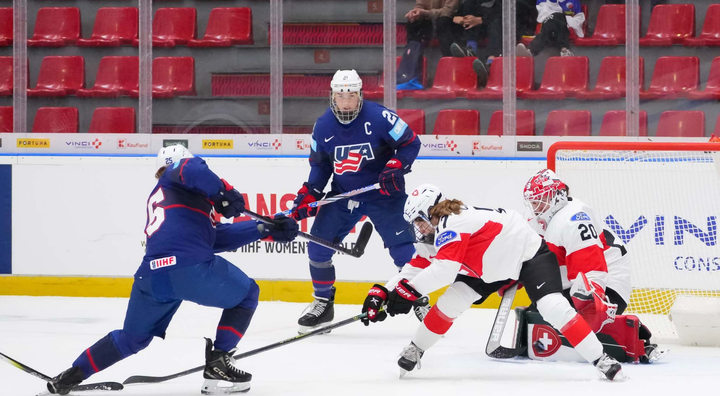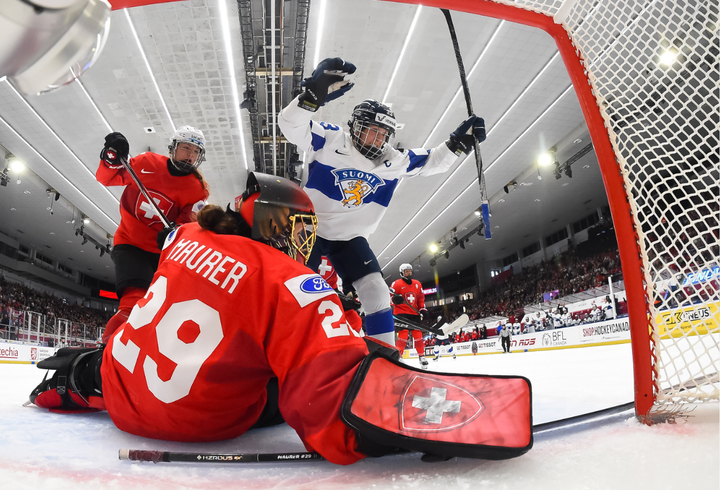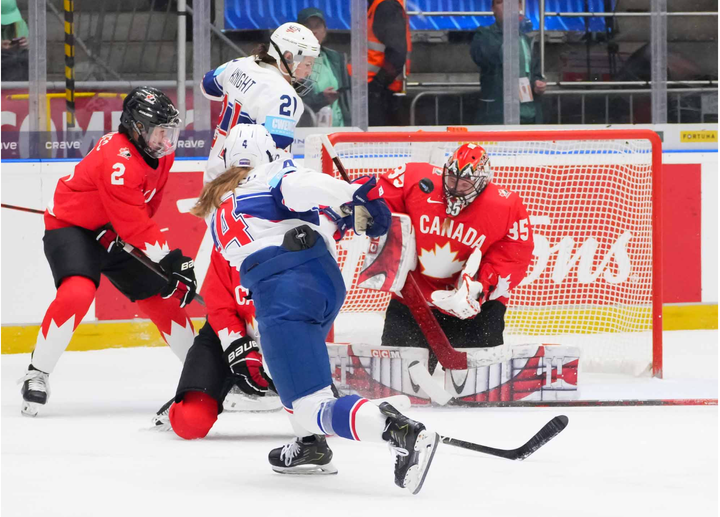For the future: How Team Sweden reached their limit
What #FörFramtiden means to the players of the Swedish Women’s Hockey National Team — and why it’s so necessary.
There is a virulent infection that penetrates all levels of women’s professional sports across the world. Its symptoms, like misogyny, sexism, and inequality, spring up like a particularly vicious hydra: make headway on one issue and another emerges to take its place. At times, the infection seems incurable.
There is, after all, no vaccine for apathy.
But, this week in Sweden, there is action.
#FörFramtiden pic.twitter.com/PdnupcS0xJ
— Erika Grahm (@erikagrahm) August 14, 2019
43 Swedish national team players announced on Aug. 14 they’ll be boycotting both a training camp and the upcoming 5 Nations Tournament that starts Aug. 20 in Finland. The coordinated release spread across social media a day before the Damkronorna were due to assemble for training camp in Bosön.
“All players invited to play for the Swedish Women’s Hockey National Team have today informed the Swedish Hockey Federation concerning a mutual and united decision ... a total of 43 players have been invited to this camp and the tournament. No one will participate in the camp nor the tournament,” begins the release, visible in English here.
They continue,
“Starting today, no one will represent the blue and yellow colors before the Swedish Hockey Federation shows us that they are willing to work beside us players to develop and create better grounds for the present roster and for all the upcoming rosters.”
The social media release came in tandem with a release from SICO, the union representing both the Damkronorna and the SDHL.
Related
Better Together: Swedish Players Unionize
The Federation’s Reaction
Tommy Boustedt, secretary general of SIF (Svenska Ishockeyförbundet, the Swedish Ice Hockey Association) responded on behalf of the federation in a press release sent out Aug. 14 at 4:27 p.m. CET. It began, “We are surprised.”
Surprised? Yes, I believe they genuinely are, because they expected the Damkronorna to continue settling for much less than their male counterparts. Underestimation is, after all, yet another symptom of the federation’s rampant apathy regarding the women. The response made zero mention of the players’ conditions, their well-documented criticisms, or how the federation plans to resolve this impasse. It’s a typical demonstration of just how disconnected the leadership is from the women’s team.
While the strike’s timing has been criticized by some, its logic is visible with a look at the Damkronorna’s season schedule. As previously reported by The Ice Garden, the 2019 Four Nations Cup is being held in Luleå in November. In addition, the Euro Hockey Tour finale is scheduled to be held in Sweden in March. It’s the same logic followed by the U.S. Women’s National Team during 2017’s #BeBoldForChange strike: apply pressure when there’s international embarrassment on the line.
The players who answered my inquiries responded identically with an English translation of their first letter. Requests for comment from SICO, Tommy Boustedt, competition manager Olof Östblom, and Damkronorna head coach Ylva Martinsen went unanswered. As of Saturday, SIF Chairman Anders Larsson has remained completely silent and left all the talking to Boustedt.
The Driving Factors Behind The Strike
Treatment
The second #FörFramtiden statement on players’ social media, and SICO’s accompanying 10 Improvement Points, both released Aug. 16, shed more light on the team’s suboptimal conditions. (SVT’s Marie Lehmann translated all 10 points into English on Twitter, and they’re well worth a read.)
Complaints about deteriorating conditions on the national team are nothing new. “During all my years in the national team, the conditions have never been worse than they are now,” forward Pernilla Winberg told DN in October 2017.
In December of that same year, defender and then-captain Emilia Ramboldt spoke to SVT Sport about the constant exhaustion of balancing her playing career with her full-time job as a preschool teacher along with her personal life as a wife and mother, saying, “I don’t know how long I can handle this.”
A survey of 23 Damkronorna players, also conducted by SVT Sport in December 2017, found more than half the team had considered quitting.
"The level is that we're extra happy if we get a new t-shirt." WOW.
— Meredith Foster (@fosterwrites) December 12, 2017
Bravo to @svt for these in-depth looks at the reality of life for elite Swedish players.
Point Four, Travel Conditions. ”A year and a half ago (a month before the Olympics), the Damkronorna, on a Saturday night, traveled home from a national team tournament in Finland with Finland’s ferry from Turku.”
For context on why that’s problematic, the ferry trip between Turku, Finland and Stockholm, Sweden takes over 10 hours. And that’s without considering additional travel time for players not based in the Stockholm region. A flight, meanwhile, takes under an hour.
The point also mentions overseas travel between Sweden and North America for tournaments like Four Nations in 2017, when the team arrived in Tampa only a day before competition began: “Aspects to take into account include a time difference of six hours and a travel time of about 15 hours. What does such a trip entail from a health perspective and injury risk? What does the SIF expect for results with these conditions?”
Point Seven, Dress. “SIF does not provide us with women’s clothing, but supplies us with men’s clothing.” According to the release, the team has spent the past five years asking the SIF for women’s clothing, only to be told no because “the SIF provides equal clothing to all national teams, i.e., men’s clothing.”
So men are the default and the women just have to deal, got it. Cool.
Point Ten, Supplements. ”SIF has nutrition and supplement partners. However, it is often the case that the ladies are awarded products whose best-before date has passed. On most occasions these are several-months-old products.”
Imagine being one of the best female athletes in the world, only to be shunted off on lengthy discount travel then handed the wrong clothes and expired nutrition supplements. The indignity glares like a misogynistic Bat Signal.
Such a lack of respect extends to the staffing choices as well. While the federation managed to quash the revolt against Leif Boork’s dismal coaching practices in 2016, they did nothing to address the players’ concerns — and kept Boork on as head coach, until after the 2018 Olympics, despite historically bad results. The Damkronorna finished at a record-low seventh place in PyeongChang under Boork, leading goaltender Minatsu Murase to comment to HockeySverige, “He ruined our Olympics.”
The players lost their Swedish Olympic Committee funding later that year.
Related
After Losing Olympic Funding, Where Does Team Sweden Go From Here?
Finances
SICO’s first statement also cited financial hardship as part of the driving force behind the action. According to the release, “The agreement signed between SIF and SICO regarding lost work income expired in April this year, and the Swedish Ice Hockey Association has chosen not to extend the contract regarding lost work income.”
In other words, the federation opted not to continue helping players make up the deficits they incur when they miss work to attend training camps or tournaments. This is a major blow, especially in the wake of lost Olympic funding. The union’s second statement elaborated on this.
Point One, Lost Income. “During the 18–19 season, the SHL offered SEK 400,000 into SIF, money that would go to the Damkronorna. The idea was that the SIF would match this amount. The SHL’s idea was that [they] wanted to help SIF invest long-term in the Damkronorna. The initiative came from the SHL when the SIF initially did not want to give Damkronorna compensation for lost work income, among other things.”
The top-tier SHL men’s league put up that money, approximately $41,408 USD, after the Olympic funding loss. The SIF did match it, for a total of SEK 800,000. However, there’s been nothing about what happened to the leftover money that didn’t go to the team, and Point One concludes, “We wonder where the excess amount from the previous season has gone?”
Boustedt and the SIF responded to the income question by turning their focus on the SDHL. He points to the SIF ceding commercial rights to the SDHL as the reason for the federation not offering any financial compensation to either the Damkronorna or other SDHL players:
“We grant all commercial rights to SDHL. There is a millionth value in the rights. The return is that SDHL will ensure that the member clubs make the players available [for Damkronorna] without salary deduction,” Boustedt told Expressen on Aug. 15. “The agreement says that the Swedish Ice Hockey Association will not pay compensation to the players or SDHL. It is the responsibility of the clubs to compensate the players.”
The problem? The SDHL, like every other professional women’s hockey league on earth, doesn’t have the resources to pay its players a living wage. Unless Boustedt has spent the past decade living under a rock, he’s well aware of that fact.
The SDHL issued a response Friday.
The #SDHL releases a statement clarifying that agreement between the SDHL and the SIF doesn’t mean that the league is responsible for compensating players for lost work income during international breaks. #FörFramtiden https://t.co/XbWMpqAdD4
— Meredith Foster (@fosterwrites) August 16, 2019
Point Two, the Insurance Issue. “How are the Damkronorna insured, and how does the SIF act in the insurance question? They insure men’s players for several millions, and we hardly have reasonably comprehensive insurance.”
A missing focus on the future
Point Five, Development. “To our knowledge, there is no elaborated, neither long-term nor short-term, development plan for how the SIF wants the Damkronorna to be run ... We want the SIF to create its own model for how the girls’ and women’s hockey teams should be run, from recruitment in youth teams to elite. What are the plans, conditions, and resources for the Damkronorna to again be able to compete for medals?”
Anders Larsson was appointed SIF chairman in June 2015 after 11 years on the Federal Board. “Development” is one of his favorite buzzwords when asked about the state of female hockey in Sweden; he frequently extols the need for a better system to shepherd the next generation of girls into the SDHL and the Damkronorna pipeline.
Four years into Larsson’s tenure, no concrete plans have emerged.
“First and foremost, I want an honest answer about where they see the Damkronorna in the organization,” said Erika Grahm on the Hockeypuls podcast earlier this year. “If they just see us as filling and something they need, or if they really want to invest in girls and women.”
“What are the plans, conditions, and resources for the Damkronorna to again be able to compete for medals?
The first #FörFramtiden statement appeals for development and is echoed in the second:
“The only thing we want is to develop Swedish women’s hockey. To do that, we need the Swedish Ice Hockey Association to help us in a different way than our men’s players need.”
What happens now?
On Friday the Finnish Ice Hockey Federation confirmed via Twitter that Sweden is out of the this leg of the Euro Hockey Tour.
According to Boustedt in SportExpressen on Friday, only a “short direct contact” has so far taken place between the SIF and SICO. No dialogue has yet emerged between the opposing parties, and there’s no telling how long this impasse could drag on.
Make no mistake: All of this was entirely preventable. The Damkronorna have been systematically and routinely mistreated, undervalued, underfunded, and blamed for the mistakes of powerful men. The federation brought this boycott on themselves with years of empty words, shrugged shoulders, and the continued indignities heaped on players who were expected to spin gold medals out of a dung heap. The players want money, yes, but they also want to be treated with respect.
They’re ready to fulfill their part of the covenant in order to get Sweden back into the top tier of women’s hockey, but “only with the appropriate resources, hospitality, and respect that share a mindset and attitude to us as professional athletes. Until the men in charge inside the Swedish Hockey Federation show us this, the Swedish Women’s Hockey National Team will have an empty roster.”
Thanks to Erik Gustafsson for Swedish translation help.





Comments ()